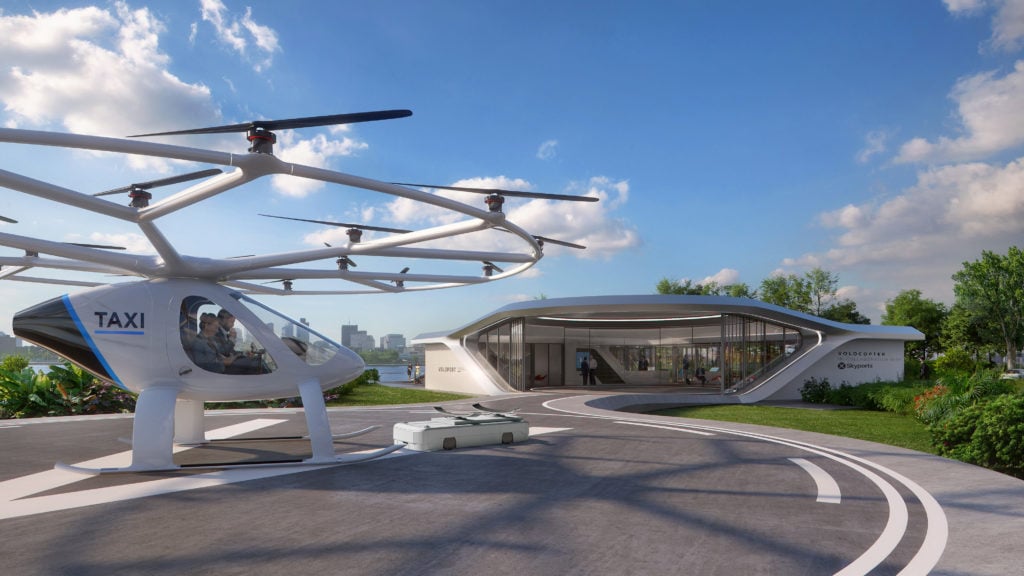Volocopter’s Flight Path Takes Shape
Share

With its electrically powered air taxi, the German company says it’s building an urban air mobility business that will bring affordable air taxi services to megacities around the world. This article originally appeared in the Expo Daily Experience: Preview. Read the full issue and register for FTE APEX Virtual Expo to learn more about urban air mobility.
Volocopter is getting its electrically powered, zero-emission VoloCity air taxi ready for takeoff. The company has plans to test and eventually deploy flying taxi services in Paris, says Hon Lung Chu, head of Volocopter for Singapore and Southeast Asia.
The initiative is partly motivated by the upcoming 2024 Olympic and Paralympic Games – the VoloCity would be a complementary mode of travel during the event. It’s one reason Volocopter, after successfully performing a test flight over Singapore’s Marina Bay in 2019, is focusing on getting commercial certification for the VoloCity from the EASA (EU Aviation Safety Agency), Chu adds.
If all goes to plan, the aim is to achieve certification by the end of 2022 or early 2023. In preparation, Volocopter set up a test site at the Pontoise airfield, 20 miles northwest of Paris.
The successful commercial launch of the two-seater VoloCity, which is equipped with 18 propellers, can carry a 440-pound payload and is inaudible from a distance of around 400 feet, would bring the promise of urban air mobility one step closer. With its green credentials and low noise profile, Chu says Volocopter hopes the electric vertical takeoff and landing (eVTOL) vehicle will gain acceptance in cities.
Currently the VoloCity can carry one passenger plus a pilot, but the company is looking at pivoting to a self-flying model three years after piloted launch, which would also give the public time to embrace the concept, Chu explains.
This means the VoloCity would be able to carry two fare-paying passengers, improving on the unit economics, though it’s still too early to anticipate the likely cost to the consumer. He does however say that the company “expects it to be competitive with premium [ground-based] taxi prices.”
[Our flights] would be significantly faster [than traditional air travel], and offer a better experience for the business traveler.” – Hon Lung Chu, head of Volocopter for Singapore and Southeast Asia
Beyond the proposed deployments, Volocopter is looking at interfacing with airports. This presents challenges in terms of airspace integration and planning with the airport operators. “There’s a required distance of separation that’s really going to determine where the takeoff and landing pads are located,” Chu says. Volocopter is considering connecting the main air flight with the VoloCity journey by means of “trains or trolleys.”
Longer-term, Volocopter has short cross-border flights in mind. This could mean flights from Singapore to Malaysia and to Indonesia. “Those are very busy checkpoints. [Our flights] would be significantly faster [than traditional air travel], and offer a better experience for the business traveler.”
Immigration, customs and quarantine would be handled within the VoloPort, the company’s name for its vertiport. “The good news is that in Singapore the security agencies and immigration authorities are already looking into more humanless, touchless interfaces, so that the entire passenger process can all be mechanized using retina and fingerprint scanners,” Chu says.
The pandemic has actually accelerated the adoption of these technologies, which means that a VoloPort could be managed with minimal staff. “Human intervention would only be required when there’s an error or the passport has an issue.”
Virtual Expo Connection – Event Agenda
Hon Lung Chu discusses urban air mobility on the panel: “Reimagining the end-to-end guest experience to deliver a safe, seamless and touchless journey”.
Dec. 8, 6:30 a.m. GMT


